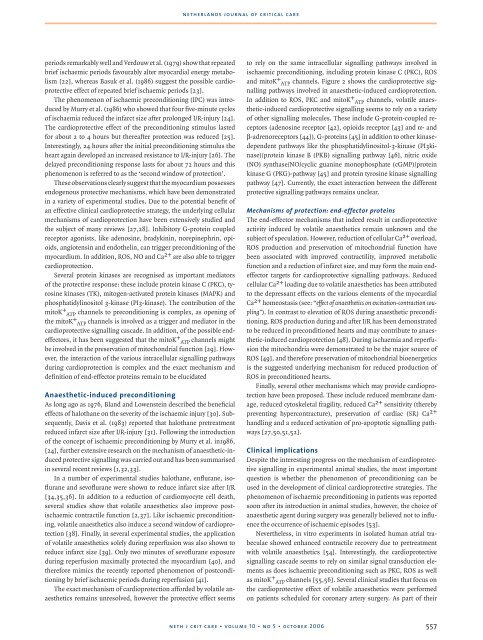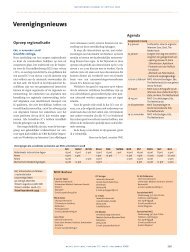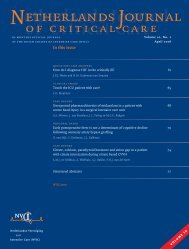Netherlands Journal
NJCC Volume 10, Oktober 2006
NJCC Volume 10, Oktober 2006
- No tags were found...
You also want an ePaper? Increase the reach of your titles
YUMPU automatically turns print PDFs into web optimized ePapers that Google loves.
netherlands journal of critical care<br />
periods remarkably well and Verdouw et al. (1979) show that repeated<br />
brief ischaemic periods favourably alter myocardial energy metabolism<br />
[22], whereas Basuk et al. (1986) suggest the possible cardioprotective<br />
effect of repeated brief ischaemic periods [23].<br />
The phenomenon of ischaemic preconditioning (IPC) was introduced<br />
by Murry et al. (1986) who showed that four five-minute cycles<br />
of ischaemia reduced the infarct size after prolonged I/R-injury [24].<br />
The cardioprotective effect of the preconditioning stimulus lasted<br />
for about 2 to 4 hours but thereafter protection was reduced [25].<br />
Interestingly, 24 hours after the initial preconditioning stimulus the<br />
heart again developed an increased resistance to I/R-injury [26]. The<br />
delayed preconditioning response lasts for about 72 hours and this<br />
phenomenon is referred to as the ‘second window of protection’.<br />
These observations clearly suggest that the myocardium possesses<br />
endogenous protective mechanisms, which have been demonstrated<br />
in a variety of experimental studies. Due to the potential benefit of<br />
an effective clinical cardioprotective strategy, the underlying cellular<br />
mechanisms of cardioprotection have been extensively studied and<br />
the subject of many reviews [27,28]. Inhibitory G-protein coupled<br />
receptor agonists, like adenosine, bradykinin, norepinephrin, opioids,<br />
angiotensin and endothelin, can trigger preconditioning of the<br />
myocardium. In addition, ROS, NO and Ca 2+ are also able to trigger<br />
cardioprotection.<br />
Several protein kinases are recognised as important mediators<br />
of the protective response: these include protein kinase C (PKC), tyrosine<br />
kinases (TK), mitogen-activated protein kinases (MAPK) and<br />
phosphatidylinositol 3-kinase (PI3-kinase). The contribution of the<br />
mitoK + ATP channels to preconditioning is complex, as opening of<br />
the mitoK + ATP channels is involved as a trigger and mediator in the<br />
cardioprotective signalling cascade. In addition, of the possible endeffectors,<br />
it has been suggested that the mitoK + ATP channels might<br />
be involved in the preservation of mitochondrial function [29]. However,<br />
the interaction of the various intracellular signalling pathways<br />
during cardioprotection is complex and the exact mechanism and<br />
definition of end-effector proteins remain to be elucidated<br />
Anaesthetic-induced preconditioning<br />
As long ago as 1976, Bland and Lowenstein described the beneficial<br />
effects of halothane on the severity of the ischaemic injury [30]. Subsequently,<br />
Davis et al. (1983) reported that halothane pretreatment<br />
reduced infarct size after I/R-injury [31]. Following the introduction<br />
of the concept of ischaemic preconditioning by Murry et al. in1986,<br />
[24], further extensive research on the mechanism of anaesthetic-induced<br />
protective signalling was carried out and has been summarised<br />
in several recent reviews [1,32,33].<br />
In a number of experimental studies halothane, enflurane, isoflurane<br />
and sevoflurane were shown to reduce infarct size after I/R<br />
[34,35,36]. In addition to a reduction of cardiomyocyte cell death,<br />
several studies show that volatile anaesthetics also improve postischaemic<br />
contractile function [2,37]. Like ischaemic preconditioning,<br />
volatile anaesthetics also induce a second window of cardioprotection<br />
[38]. Finally, in several experimental studies, the application<br />
of volatile anaesthetics solely during reperfusion was also shown to<br />
reduce infarct size [39]. Only two minutes of sevoflurane exposure<br />
during reperfusion maximally protected the myocardium [40], and<br />
therefore mimics the recently reported phenomenon of postconditioning<br />
by brief ischaemic periods during reperfusion [41].<br />
The exact mechanism of cardioprotection afforded by volatile anaesthetics<br />
remains unresolved, however the protective effect seems<br />
to rely on the same intracellular signalling pathways involved in<br />
ischaemic preconditioning, including protein kinase C (PKC), ROS<br />
and mitoK + ATP channels. Figure 2 shows the cardioprotective signalling<br />
pathways involved in anaesthetic-induced cardioprotection.<br />
In addition to ROS, PKC and mitoK + ATP channels, volatile anaesthetic-induced<br />
cardioprotective signalling seems to rely on a variety<br />
of other signalling molecules. These include G-protein-coupled receptors<br />
(adenosine receptor [42], opioids receptor [43] and α- and<br />
β-adrenoreceptors [44]), G-proteins [45] in addition to other kinasedependent<br />
pathways like the phosphatidylinositol-3-kinase (PI3kinase)/protein<br />
kinase B (PKB) signalling pathway [46], nitric oxide<br />
(NO) synthase/NO/cyclic guanine monophosphate (cGMP)/protein<br />
kinase G (PKG)-pathway [45] and protein tyrosine kinase signalling<br />
pathway [47]. Currently, the exact interaction between the different<br />
protective signalling pathways remains unclear.<br />
Mechanisms of protection: end-effector proteins<br />
The end-effector mechanisms that indeed result in cardioprotective<br />
activity induced by volatile anaesthetics remain unknown and the<br />
subject of speculation. However, reduction of cellular Ca 2+ overload,<br />
ROS production and preservation of mitochondrial function have<br />
been associated with improved contractility, improved metabolic<br />
function and a reduction of infarct size, and may form the main endeffector<br />
targets for cardioprotective signalling pathways. Reduced<br />
cellular Ca 2+ loading due to volatile anaesthetics has been attributed<br />
to the depressant effects on the various elements of the myocardial<br />
Ca 2+ homeostasis (see: “effect of anaesthetics on excitation-contraction coupling”).<br />
In contrast to elevation of ROS during anaesthetic preconditioning,<br />
ROS production during and after I/R has been demonstrated<br />
to be reduced in preconditioned hearts and may contribute to anaesthetic-induced<br />
cardioprotection [48]. During ischaemia and reperfusion<br />
the mitochondria were demonstrated to be the major source of<br />
ROS [49], and therefore preservation of mitochondrial bioenergetics<br />
is the suggested underlying mechanism for reduced production of<br />
ROS in preconditioned hearts.<br />
Finally, several other mechanisms which may provide cardioprotection<br />
have been proposed. These include reduced membrane damage,<br />
reduced cytoskeletal fragility, reduced Ca 2+ sensitivity (thereby<br />
preventing hypercontracture), preservation of cardiac (SR) Ca 2+<br />
handling and a reduced activation of pro-apoptotic signalling pathways<br />
[27,50,51,52].<br />
Clinical implications<br />
Despite the interesting progress on the mechanism of cardioprotective<br />
signalling in experimental animal studies, the most important<br />
question is whether the phenomenon of preconditioning can be<br />
used in the development of clinical cardioprotective strategies. The<br />
phenomenon of ischaemic preconditioning in patients was reported<br />
soon after its introduction in animal studies, however, the choice of<br />
anaesthetic agent during surgery was generally believed not to influence<br />
the occurrence of ischaemic episodes [53].<br />
Nevertheless, in vitro experiments in isolated human atrial trabeculae<br />
showed enhanced contractile recovery due to pretreatment<br />
with volatile anaesthetics [54]. Interestingly, the cardioprotective<br />
signalling cascade seems to rely on similar signal transduction elements<br />
as does ischaemic preconditioning such as PKC, ROS as well<br />
as mitoK + ATP channels [55,56]. Several clinical studies that focus on<br />
the cardioprotective effect of volatile anaesthetics were performed<br />
on patients scheduled for coronary artery surgery. As part of their<br />
neth j crit care • volume 10 • no 5 • october 2006<br />
557







